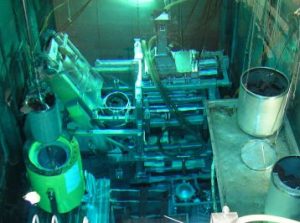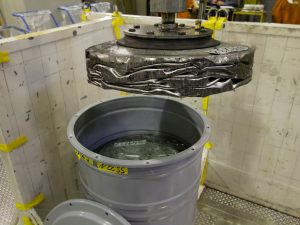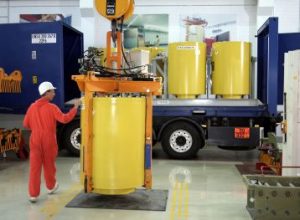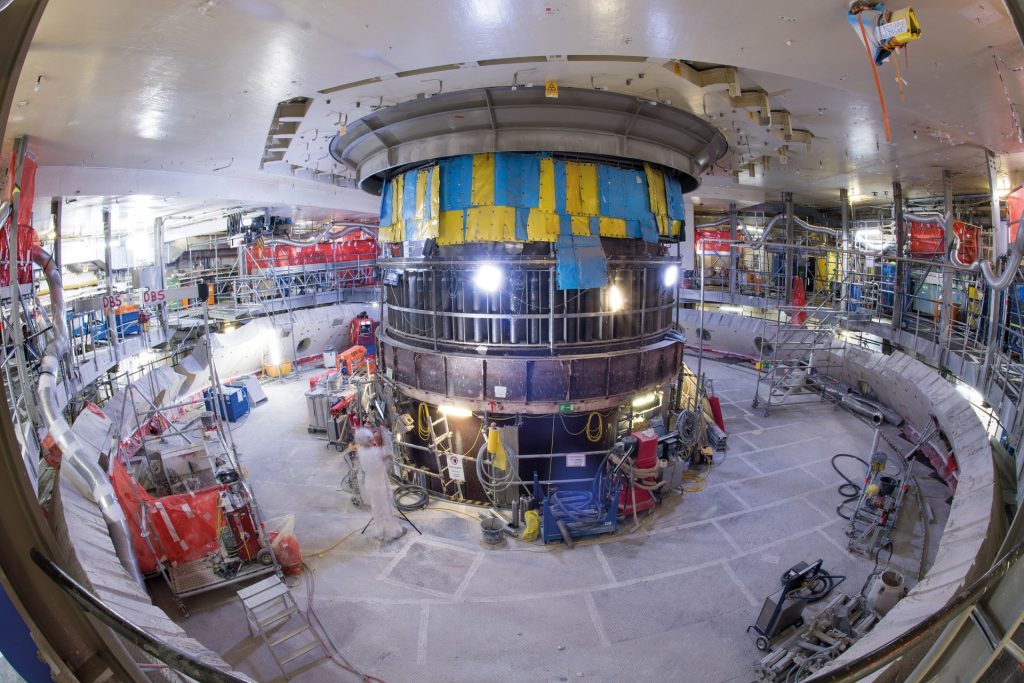Dismantling
Following the accelerated phase-out of the use of nuclear energy to generate electricity in Germany, the task of dismantling nuclear power plants has come to the fore. The aim is to safely and efficiently dismantle the power plant site so that it can be renaturalised or used for other purposes. The decommissioning of a shut-down nuclear power plant is provided for in the Atomic Energy Act and the costs are borne by the operator of the power plant. A separate licence is required for dismantling, which is issued by the nuclear supervisory authority.
Immediately after the shutdown of a nuclear power plant, the spent fuel elements are still in the plant, which is managed in post-operation with its existing operating licence. This post-operational phase usually lasts around four to five years, during which the fuel elements are removed from the plant to the on-site interim storage facility and plant components that are required for power operation can be dismantled. These may include cooling towers, machine transformers or the turbines and generator in pressurised water reactors. Various components can also be removed from the reactor building and decontamination work can take place in preparation for dismantling.
The centrepiece of decommissioning is the dismantling of the nuclear part of the plant and the management of radioactive waste. Decommissioning is a technically and organisationally demanding task and requires specific expertise. There is already extensive experience in Germany and abroad, both in terms of planning and implementation as well as special techniques for decontamination and the dismantling of plant components.
The dismantling of nuclear power plants and other nuclear facilities is not new territory in Germany: three nuclear power plants and a number of other nuclear facilities have already been completely dismantled. Larger commercial nuclear power plants at the Stade, Obrigheim, Mülheim-Kärlich and Greifswald sites are also being dismantled, while nuclear dismantling has already been completed at the Würgassen site. Of the nuclear power plants that lost their authorisation to operate with the 13th amendment to the Atomic Energy Act in 2011, five plants received their decommissioning and dismantling licences: Isar 1, Neckarwestheim 1, Philippsburg 1, Biblis A and B.
The aim of decommissioning is generally to completely dismantle the plant down to the so-called "greenfield site" or an unrestricted subsequent utilisation of the power plant site. Nuclear dismantling following the post-operational phase is estimated to take around 10 to 15 years, at the end of which conventional demolition will take place if the buildings are not reused. The techniques for dismantling are tried and tested, experienced specialist personnel are available and the authorisation and management of decommissioning are carried out according to established procedures. As a result, there are no specific risks to the population, the environment or personnel during the dismantling of nuclear power plants.
However, the vast majority of the materials produced during dismantling can be recycled or conventionally landfilled. The breakdown of the material flows into the categories of radioactive waste, waste requiring landfill and recyclable residues is shown in a Release proceduren in accordance with the Radiation Protection Act.
The plan is to transport the low and intermediate level waste to the Konrad repository, which is currently being built and should be available in the mid-twenties. The spent fuel elements are to be deposited in a repository for high-level radioactive waste, for which a site is currently being sought. It is currently not possible to reliably estimate when such a repository will be ready for operation.
 Low and intermediate-level waste in particular is very diverse in terms of chemical composition and consistency. In order to safely package all types of this radioactive waste, various conditioning processes and facilities are available. The ultimate aim is to fulfil the acceptance requirements for the future Konrad repository.
Low and intermediate-level waste in particular is very diverse in terms of chemical composition and consistency. In order to safely package all types of this radioactive waste, various conditioning processes and facilities are available. The ultimate aim is to fulfil the acceptance requirements for the future Konrad repository.

Liquid waste can be evaporated or cemented. Solid waste is crushed, dried, incinerated, melted, compacted (= compressed) or cemented. If the waste has been processed into solid waste products (such as pellets or concentrates), it is packaged in standardised containers approved for this purpose. It is important that the waste and containers comply with the specifications. Different types of radioactive waste may be packaged together, but a reaction between the waste types, the fixative (usually concrete) and the packaging must be ruled out as far as possible.
Containers for the (final) storage of low and intermediate level waste
There are three different types of tanks, which are available in numerous variants: cylindrical concrete tanks, cylindrical cast iron tanks and containers.
The cylindrical concrete containers are generally used for fixed waste and can be made of normal or heavy concrete. Drums with radioactive waste in the size of 200 or 400 litres are placed in them. Cavities are then filled with concrete.

Cylindrical cast iron containers are mostly used for packaging loose waste. Depending on the requirements, different dimensions and wall thicknesses are available for shielding.
Containers are large cuboid containers made of steel, reinforced concrete or a cast material, which are available in different sizes and with different wall thicknesses. Depending on the type, drums or components can be loaded into the containers. Here too, the cavities are usually filled with concrete. Finally, all container types are permanently sealed with a lid.
During the dismantling of nuclear power plants and other nuclear facilities, many different materials (e.g. cables and cable insulation, pump housings, concrete rubble, reinforcements) are produced from the various plant areas. Larger parts of nuclear power plants are generally not exposed to radioactive contamination or activation, such as the operational cooling system (condensers, cooling towers), the turbine house in pressurised water reactors, emergency power systems, administrative buildings, workshops, etc.
In the context of decommissioning and dismantling, these areas can be released from nuclear monitoring by the supervisory authority without a release procedure in accordance with the authorisation requirements. As with other industrial plants, commercial or residential buildings, dismantling and demolition work is carried out in accordance with the provisions of the Closed Substance Cycle and Waste Management Act, the applicable building regulations, immission control regulations, hazardous substances regulations, etc.
The dismantling of facilities and buildings from the controlled area is subject to nuclear supervision in addition to the above-mentioned provisions. The handling of these material flows is regulated in the Radiation Protection Ordinance (StrlSchV) with the clearance procedure according to § 29. A distinction is made between three categories of residual materials/waste:
- Radioactive waste that must be stored in a repository for (low- and intermediate-level) radioactive waste
- Non-hazardous substances with low levels of radioactivity that do not have to be disposed of in a repository but in landfills
- Recyclable residual materials that fulfil the limit values for unrestricted release and can be sent for conventional recycling without restriction.
Both waste requiring landfill and recyclable residual materials are not considered radioactive waste, as they are released from the scope of the Atomic Energy Act via a clearance procedure in accordance with Section 29 StrlSchV, which is why they are referred to as clearance or clearance measurement. The waste subject to landfill must fulfil the condition that a dose limit of 10 microsieverts (0.01 millisieverts) per year is not exceeded for employees or members of the general public, such as people living near the landfill. This corresponds to 0.5 per cent of the average natural dose in Germany of 2.1 millisieverts per year.
To categorise the clearance limit value of 0.01 millisieverts per year, a comparison: this value is 100 times lower than the value that is considered harmless for building materials for residential buildings or for the disposal of material enriched with natural radioactivity (1 millisievert per year). Building materials with increased natural radioactivity include granite, gneiss, porphyry and tuff, sand and plasterboard or lightweight concrete made with alum slate.
The operator of the plant, e.g. the nuclear power plant, carries out the release procedure in several steps in expert-tested measuring equipment authorised by the supervisory authority in accordance with prescribed procedures. In practice, the material from the dismantling is measured in standardised metal baskets in a calibrated measuring chamber and the results of the measurements and the material properties are documented. Approval can only be granted by the supervisory authority, and the approved materials are regularly tested in random samples by experts on behalf of the supervisory authority.
After approval, the other waste regulations are applied to the materials and a large proportion can be recycled, as provided for in the Closed Substance Cycle Waste Management Act. For example, construction waste can be utilised in road construction, metals can be reused in production, etc.
Landfills from class one and 10,000 tonnes per year are suitable for waste requiring landfill. There are also quantity limits for acceptance by the landfill. The Radiation Protection Ordinance regulates in detail nuclide-specific upper limits for the release for landfilling and utilisation for various groups of materials from dismantling.
Incidentally, the subdivision into landfillable and recyclable does not only exist in accordance with the Radiation Protection Ordinance, but generally applies to potentially or actually contaminated waste. For example, roof tiles, masonry, concrete and screed are considered recyclable construction waste in the case of everyday, conventional demolition of residential buildings. Mortar and plaster or gravel and sand, on the other hand, are subject to landfill, and material from the demolition of chimneys may have to be treated as hazardous waste.
The operators of nuclear power plants and other nuclear facilities are legally obliged to cover the costs of the Decommissioning and dismantling of their plants and those of the Conditioning and provision of radioactive waste from operation and decommissioning. These costs are incurred to a lesser extent during operation and to a greater extent after decommissioning over a period of around 20 years. The operators of nuclear power plants in Germany have recognised provisions of more than 20 billion euros in their balance sheets for these obligations.
Provisions in this and other areas are recognised for future payment obligations that are uncertain in terms of amount or due date. The legal basis for provisions in the nuclear energy sector is the Atomic Energy Act, which obliges the operators to assume these future costs, and commercial law, according to which such foreseeable payment obligations must be recognised in the balance sheet.
Specifically, the obligations of nuclear power plant operators in this area include the decommissioning and dismantling of nuclear power plants, the packaging of irradiated fuel elements and radioactive waste from reprocessing as well as the conditioning and packaging of other radioactive waste, including operational waste, and the return of radioactive waste from reprocessing.




